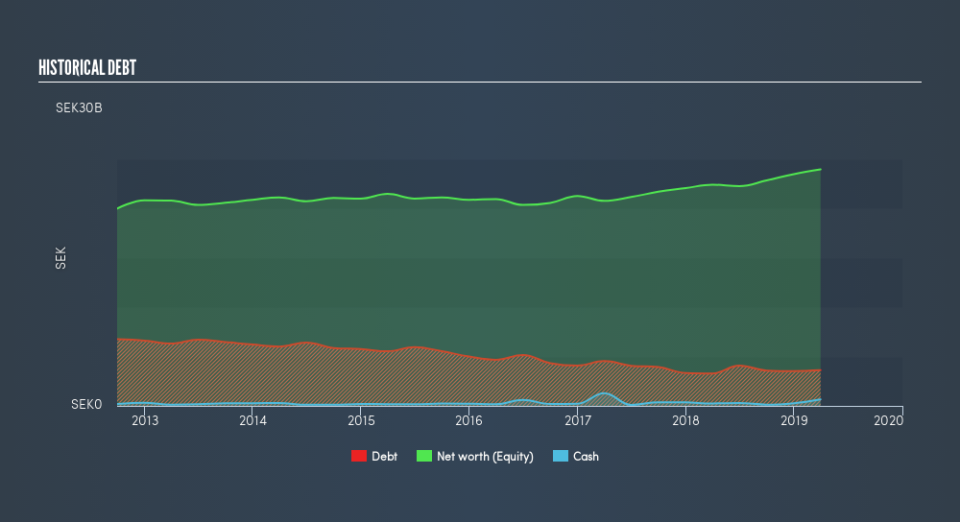Holmen Aktiebolag (publ.) (STO:HOLM B) Seems To Use Debt Quite Sensibly

The external fund manager backed by Berkshire Hathaway's Charlie Munger, Li Lu, makes no bones about it when he says 'The biggest investment risk is not the volatility of prices, but whether you will suffer a permanent loss of capital.' So it seems the smart money knows that debt - which is usually involved in bankruptcies - is a very important factor, when you assess how risky a company is. We can see that Holmen Aktiebolag (publ.) (STO:HOLM B) does use debt in its business. But is this debt a concern to shareholders?
When Is Debt Dangerous?
Generally speaking, debt only becomes a real problem when a company can't easily pay it off, either by raising capital or with its own cash flow. Part and parcel of capitalism is the process of 'creative destruction' where failed businesses are mercilessly liquidated by their bankers. However, a more common (but still painful) scenario is that it has to raise new equity capital at a low price, thus permanently diluting shareholders. Of course, the upside of debt is that it often represents cheap capital, especially when it replaces dilution in a company with the ability to reinvest at high rates of return. When we think about a company's use of debt, we first look at cash and debt together.
Check out our latest analysis for Holmen Aktiebolag (publ.)
What Is Holmen Aktiebolag (publ.)'s Debt?
As you can see below, at the end of March 2019, Holmen Aktiebolag (publ.) had kr3.83b of debt, up from kr3.29b a year ago. Click the image for more detail. However, it also had kr659.0m in cash, and so its net debt is kr3.17b.
A Look At Holmen Aktiebolag (publ.)'s Liabilities
We can see from the most recent balance sheet that Holmen Aktiebolag (publ.) had liabilities of kr6.68b falling due within a year, and liabilities of kr7.52b due beyond that. Offsetting this, it had kr659.0m in cash and kr3.57b in receivables that were due within 12 months. So its liabilities total kr9.98b more than the combination of its cash and short-term receivables.
While this might seem like a lot, it is not so bad since Holmen Aktiebolag (publ.) has a market capitalization of kr34.5b, and so it could probably strengthen its balance sheet by raising capital if it needed to. But we definitely want to keep our eyes open to indications that its debt is bringing too much risk.
We use two main ratios to inform us about debt levels relative to earnings. The first is net debt divided by earnings before interest, tax, depreciation, and amortization (EBITDA), while the second is how many times its earnings before interest and tax (EBIT) covers its interest expense (or its interest cover, for short). The advantage of this approach is that we take into account both the absolute quantum of debt (with net debt to EBITDA) and the actual interest expenses associated with that debt (with its interest cover ratio).
Holmen Aktiebolag (publ.)'s net debt is only 1.1 times its EBITDA. And its EBIT covers its interest expense a whopping 76.7 times over. So you could argue it is no more threatened by its debt than an elephant is by a mouse. And we also note warmly that Holmen Aktiebolag (publ.) grew its EBIT by 10% last year, making its debt load easier to handle. The balance sheet is clearly the area to focus on when you are analysing debt. But ultimately the future profitability of the business will decide if Holmen Aktiebolag (publ.) can strengthen its balance sheet over time. So if you want to see what the professionals think, you might find this free report on analyst profit forecasts to be interesting.
But our final consideration is also important, because a company cannot pay debt with paper profits; it needs cold hard cash. So the logical step is to look at the proportion of that EBIT that is matched by actual free cash flow. During the last three years, Holmen Aktiebolag (publ.) produced sturdy free cash flow equating to 73% of its EBIT, about what we'd expect. This cold hard cash means it can reduce its debt when it wants to.
Our View
Happily, Holmen Aktiebolag (publ.)'s impressive interest cover implies it has the upper hand on its debt. And that's just the beginning of the good news since its conversion of EBIT to free cash flow is also very heartening. Taking all this data into account, it seems to us that Holmen Aktiebolag (publ.) takes a pretty sensible approach to debt. That means they are taking on a bit more risk, in the hope of boosting shareholder returns. We'd be motivated to research the stock further if we found out that Holmen Aktiebolag (publ.) insiders have bought shares recently. If you would too, then you're in luck, since today we're sharing our list of reported insider transactions for free.
If, after all that, you're more interested in a fast growing company with a rock-solid balance sheet, then check out our list of net cash growth stocks without delay.
We aim to bring you long-term focused research analysis driven by fundamental data. Note that our analysis may not factor in the latest price-sensitive company announcements or qualitative material.
If you spot an error that warrants correction, please contact the editor at editorial-team@simplywallst.com. This article by Simply Wall St is general in nature. It does not constitute a recommendation to buy or sell any stock, and does not take account of your objectives, or your financial situation. Simply Wall St has no position in the stocks mentioned. Thank you for reading.

